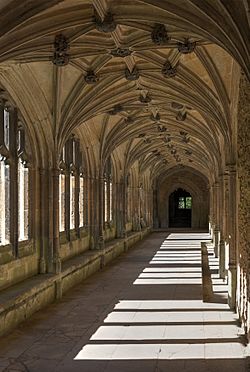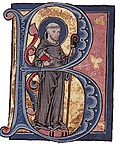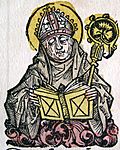Lacock Abbey (monastery) facts for kids

Lacock Abbey, the cloister
|
|
| Monastery information | |
|---|---|
| Full name | The Abbey Church of the Blessed Mary and St Bernard |
| Other names | "locus beate Marie" ("the place of the Blessed Mary") |
| Order | Augustinian Canonesses regular |
| Established | 1229 |
| Disestablished | 1539 |
| Dedicated to | Virgin Mary |
| Diocese | Salisbury |
| People | |
| Founder(s) | Ela, 3rd Countess of Salisbury |
| Site | |
| Location | Lacock, Wiltshire, England |
| Visible remains | most extensive remains of a medieval nunnery in England, but church demolished |
| Public access | National Trust |
Lacock Abbey was a monastery (a place where religious people live and work) founded in Lacock, Wiltshire, England. It was started in the early 1200s by Ela, Countess of Salisbury. It was a home for Augustinian nuns, who were women dedicated to a religious life. In 1539, King Henry VIII took control of the abbey during a time called the Dissolution of the Monasteries. After that, it became a large country house. Lacock Abbey is also famous because Henry Fox Talbot did his first photography experiments there.
Contents
Starting the Abbey and Its Founder
The idea to build Lacock Abbey came from Ela, Countess of Salisbury in 1226. Ela was the only child of William FitzPatrick, the Earl of Salisbury. When her father died, she became the Countess of Salisbury. When she was only nine years old, she married William Longespée, who was a son of King Henry II.
Countess Ela decided to found the abbey shortly after her husband passed away. In 1229, she gave her land in Lacock to God, the Blessed Mary, and St Bernard. This land was for building an abbey for nuns, which would be called "locus beate Marie" (meaning "the place of the Blessed Mary"). King Henry III later approved this plan.
Countess Ela herself laid the first stone of the abbey on April 16, 1232. The abbey was built on a piece of land called Snail's Meadow, between the village and the River Avon. The first nuns joined the abbey in 1232.
At first, Ela probably wanted the abbey to be part of the Cistercian Order. However, the Cistercian leaders decided not to take on any more convents for women. So, in 1230, the Bishop of Salisbury, Robert Bingham, said the nuns should follow the Rule of St Augustine. This made Lacock Abbey one of the few Augustinian nunneries in England.
Ela likely planned to become the abbess (the head nun) of her own abbey from the start. She joined the nuns in late 1237 or early 1238. She was elected abbess by August 15, 1239. She led the abbey until December 31, 1257, when she stepped down. Ela died on August 24, 1261, and was buried in the abbey church. Over time, Ela and her son added more lands to the abbey's property.
How the Abbey Grew
Throughout the 1200s, Lady Ela's family stayed connected to the abbey. They gave it money and chose it as a special burial place. Two of Ela's sons were buried there, as was the heart of a third son. Her granddaughter, Margaret, also showed great interest in the abbey and was buried there in 1309. Other granddaughters became nuns at Lacock.
Building the abbey took a long time. King Henry III gave wood for construction in 1246 and 1264, and money in 1247. King Edward I also gave wood in 1285.
The abbey also gained special rights, like holding a fair in Lacock and markets in Lacock and Chitterne. They also received land and rights to gather wood from the king. Many noble families also gave land and money to the abbey, even after Ela died.
In the 1300s, the abbey added a special chapel for the Virgin Mary and a separate place for the abbess to live. They also made big changes to the sleeping area (dorter) and dining hall (frater). Work on the cloister (a covered walkway) continued into the next century. An early improvement was a water pipe built to bring water from Bowden Hill.
Over time, fewer noblewomen became nuns. Instead, daughters of wealthy landowners and townspeople joined. For example, in 1395, records show the costs for clothing a new nun named Joan. Her clothes included a white wool tunic, a summer cloak, a winter fur-lined cloak, a fur pilch (a leather cloak), a veil, and a wimple. She also had a bed, blankets, a silver spoon, and a special bowl.
Like many medieval nunneries, Lacock Abbey sometimes struggled with money. In 1403, it was excused from royal taxes because it was poor. In 1447, it received a 40-year tax break after lightning struck and destroyed the bell-tower, bells, bakehouse, brewery, and two barns full of grain.
The abbey earned money from farming and other sources. Over the centuries, they often rented out their lands instead of farming them directly. This included a coal mine they owned and leased out. In 1476, the abbey had a large flock of over 2,000 sheep, mostly on their Chitterne land. Records from 1535 and 1536 show that the abbey was "very clean, well prepared and well ordered" and its buildings were "in very good state."
Spiritual Life
We don't have many records about how bishops checked on the abbey's spiritual health. However, we know these visits happened. For example, in 1347, the abbey bought salmon, lobsters, crabs, and lampreys for a visit from the Bishop of Salisbury. This shows they wanted to make a good impression!
The nuns also had duties to pray for people who had given them money or land. For example, a man named Sir John Bluet asked to be buried in a Lady chapel. In return, the nuns agreed to pray for him and his wife, and to give money to a thousand poor people on his anniversary.
The number of nuns at Lacock Abbey was never very high. In 1395, there were 22 nuns. By 1473, there were only 14. At the time the abbey was closed, there were 17 members, including 3 new nuns. This suggests that the abbey was still a popular choice for women wanting to join a religious community. The abbey seemed to be well-run and had no major scandals reported.
Abbesses of Lacock
This list might not be complete. The dates show when they were mentioned in records, not the exact start and end of their time in office.
- Wymarca (prioress)
- Ela (first abbess) (1239–1257)
- Beatrice of Kent (1257–1269?)
- Alice (1282, 1286)
- Juliana (1288, 1290)
- Agnes (1299)
- Joan de Montfort (1303?–1332)
- Katherine le Cras (1332–1334)
- Sybil de Sainte Croix (1334–1349)
- Maud de Montfort (1349–1356)
- Agnes de Brymesden (1356–1361)
- Faith Selyman (1361-?1380)
- Agnes de Wyke (1380-?)
- Ellen de Montfort (1405-?)
- Agnes Frary or Fray (1429–1445)
- Agnes Draper (1445–1473)
- Margery Glowceteror or Gloucestrie (1473-?)
- Joan Temse or Temmse, Temys (1516?–1539)
Books at the Abbey
Not all medieval nuns could read, but some were very interested in books. The abbey would have had a small library. This library would include religious texts like the Bible, stories about saints, and other spiritual books. They might also have had books on practical subjects, as running an abbey was a big job! Also, the nuns needed special books for their daily prayers and church services. The priests who helped the nuns would also need their own religious books.
It's thought that a book called Speculum Ecclesiae might have been written for Ela and her community by Saint Edmund Rich (who died in 1240). However, we can't be sure if any copies of this book came from Lacock Abbey. Today, only three books are known to have definitely belonged to Lacock Abbey.
In 1399, the Bishop of Salisbury, Ralph Erghum, left the Abbess of Lacock his "beautiful psalter" (a book of psalms). This might be a psalter now kept in the Bodleian Library.
In 2011, two books that used to be at the abbey were sold. One was a decorated manuscript (a handwritten book) of a 12th-century work called Expositiones Vocabulorum Biblie. This book was bought by the National Trust and is now kept at Lacock Abbey. It shows signs of having been chained, and it even has 13th-century financial records of the abbey in its binding!
The other book sold was a collection of poems in Anglo-Norman (an old French language spoken in England). It included a work called Le tretiz. This book is also a decorated manuscript from the 1300s. Its binding includes pages from another manuscript from around 1300, which has notes about the writings of St Thomas Aquinas.
The British Library also bought the abbey's cartularies (books of copies of important documents) in 2011. These are now kept in two volumes and can be viewed online.
The Abbey's Seal
The abbey used a special seal to mark important documents. We still have several examples of this seal from the 1200s to the 1500s. The seal is shaped like a pointed oval. It shows the Virgin Mary wearing a crown and sitting on a fancy throne, holding the Child Jesus on her left knee. Above them is a decorated canopy, and below is a kneeling figure praying. The words on the seal say "S' CONVENT BEATE MARIE SANCTI B'NARDI DE LACOC," which means "Seal of the Convent of the Blessed Mary and St Bernard of Lacock."
The image of the Virgin Mary with the Child Jesus is called the Seat of Wisdom. This was a common image for nunnery seals in medieval England.
The abbesses also had their own personal seals. We have examples of Lady Ela's seal as abbess. It also shows the Virgin Mary and Child Jesus under a canopy. The words on her seal mean "Seal of Ela, abbess of Lacock."
The Priory's seal (another part of the abbey) sometimes showed the Coronation of the Virgin Mary, which was not as common for nunneries in England.
The Abbey is Taken Over
In 1536, government officials reported that Lacock Abbey was a "great relief" for the town and nearby areas. They also said the nuns were "virtuous" and wanted to continue their religious life. However, King Henry VIII's main goal was to take the wealth of the monasteries. The abbey's income was around £203, which was just above the £200 limit for smaller monasteries to be closed. So, on January 30, 1537, the abbey paid a large "fine" of £300 to keep going. But the demands continued, and the end came less than two years later.
On January 21, 1539, the abbey was officially given to the King's representatives. The nuns were sent away, but they received a pension (money paid regularly). The abbess received the most, £40, while the prioress received £5, and the newest nuns received £2 each. Within a year, two nuns had died, and 14 years later, only seven of the original nuns were still receiving their pensions.
Becoming a Country House
After the abbey was closed, its buildings were stripped of valuable lead, which was sold for £193. Then, the property was sold to William Sharington, who later became Sir William Sharington. He was a courtier, politician, and businessman. He bought the abbey and its lands for £783 in the summer of 1540. He tore down the church and changed the remaining buildings into a home. He even used money from selling the church bells to rebuild a bridge, so the public road wouldn't lead directly to his new house.
The New Owner
William Sharington became the head of the royal mint in Bristol. He faced some challenges but managed to keep his estates, including Lacock Abbey, after paying a large fine. After that, Lacock Abbey stayed in his family through inheritance until 1944. At that time, it was given to the National Trust, which now cares for it.
See also




